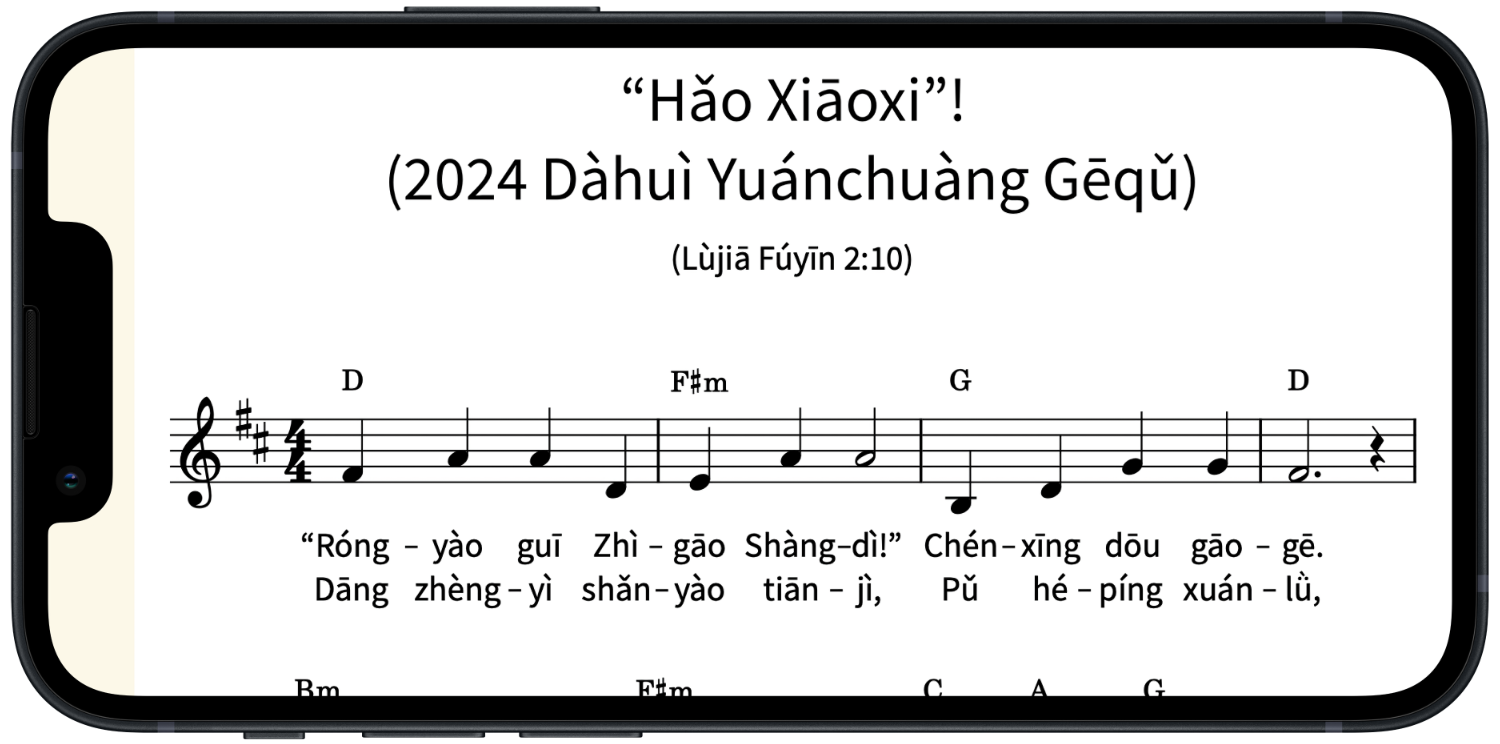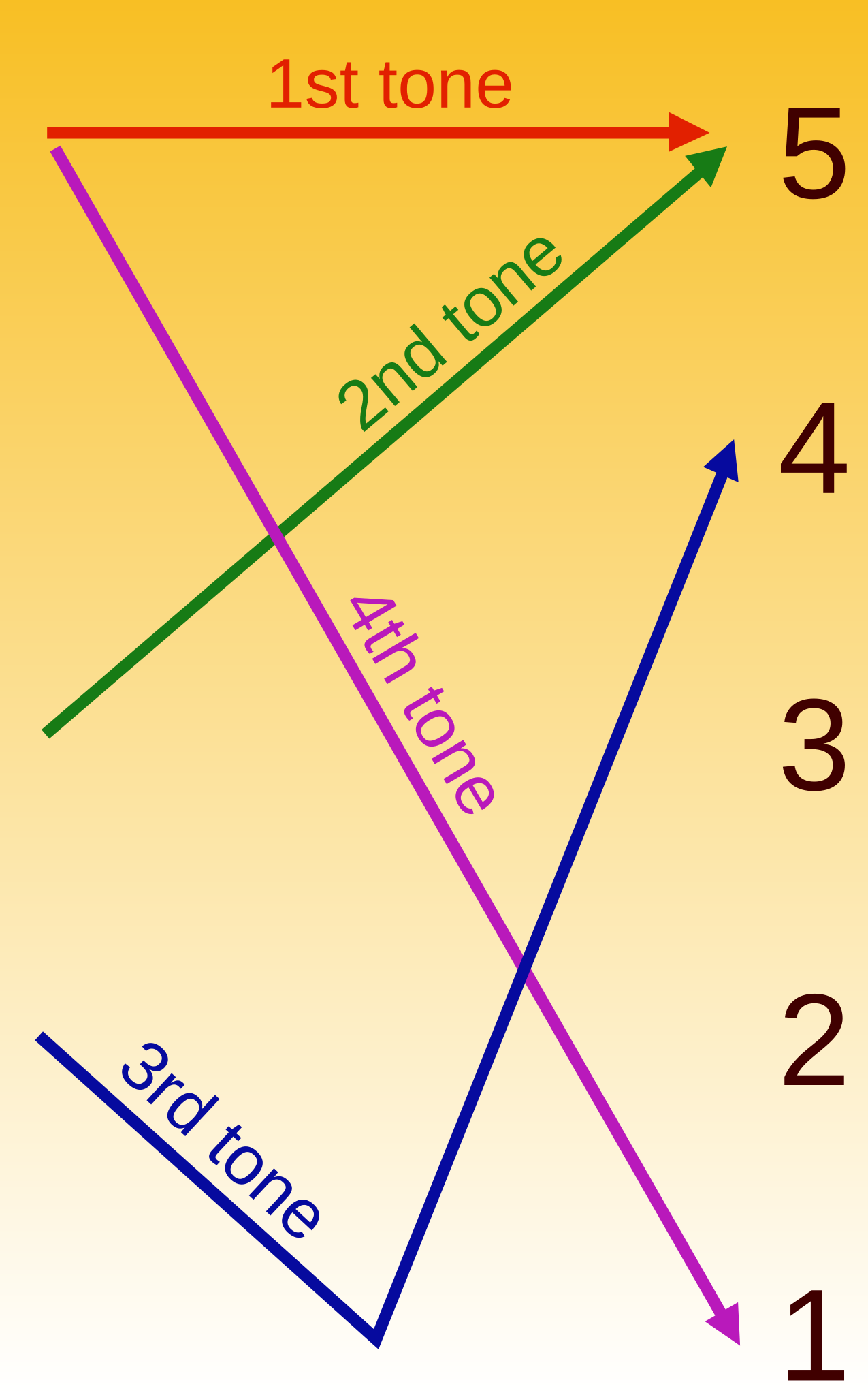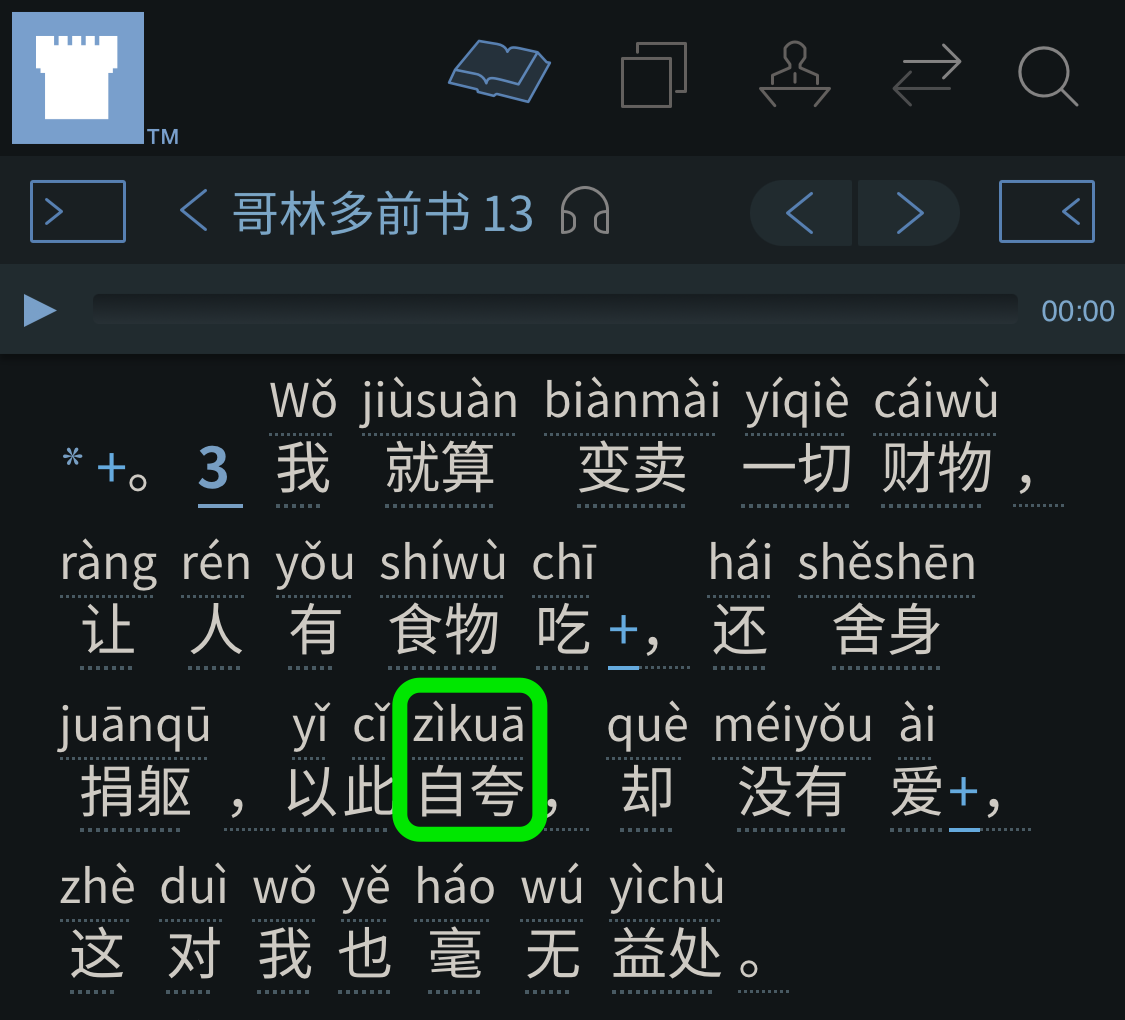pǔ ({register or record for reference} [→ [musical notation [→ [set to music; compose (music)]] | sth. to base oneself on | table; chart; list | guide; manual | standards | airs; pretensions | spectrum (physics)]] 谱 譜) ← Tap/click to show/hide the “flashcard”
[Notes: Tap/click on a Pīnyīn (Pīn·yīn {Piecing Together of} · Sounds → [Pinyin] 拼音) expression to reveal its “flashcard”; tap/click on a “flashcard” or its Pīnyīn (Pīn·yīn {Piecing Together of} · Sounds → [Pinyin] 拼音) expression to hide the “flashcard”. 📖 📄 📘 icons mean 📖 Reveal All, 📄 Reveal Advanced, and 📘 Reveal None re all the “flashcards” in the heading, paragraph, etc. that they are placed at the beginning of.]
Summer is nearing, and soon, many of us will be singing together in Mandarin at our Mandarin conventions. Unfortunately, at the time of this writing, there was no official Pīnyīn (Pīn·yīn {Piecing Together of} · Sounds → [Pinyin] 拼音) available on the official page for the Mandarin version of this year’s convention song, but I am happy to report that proofread Pīnyīn (Pīn·yīn {Piecing Together of} · Sounds → [Pinyin] 拼音) lyrics or better and proofread musical notation 🎼 with Pīnyīn (Pīn·yīn {Piecing Together of} · Sounds → [Pinyin] 拼音) lyrics for this year’s convention song, and for all the other songs scheduled to be sung at this year’s Mandarin conventions, are now available at this unofficial Pīnyīn (Pīn·yīn {Piecing Together of} · Sounds → [Pinyin] 拼音) Plus resource:

[Note: As with all the other Pīnyīn (Pīn·yīn {Piecing Together of} · Sounds → [Pinyin] 拼音) Plus resources, the above-mentioned Pīnyīn (Pīn·yīn {Piecing Together of} · Sounds → [Pinyin] 拼音) Plus resource is made to be supplementary language-learning material for those learning the Mandarin language to help others in the Mandarin field. For spiritual food (which is for you yourself to learn spiritual things from, and which ideally should be in your own mother tongue), please go to jw.org.]
Very Lyrical Mandarin Lyrics
This week’s MEotW, “pǔ ({register or record for reference} [→ [musical notation [→ [set to music; compose (music)]] | sth. to base oneself on | table; chart; list | guide; manual | standards | airs; pretensions | spectrum (physics)]] 谱 譜)”, comes from the second verse of the Mandarin version of this year’s convention song:
He will reign for righteousness.
Peace he will provide.
Jesus is the way to endless life.
Mandarin (jw.org, Pīnyīn (Pīn·yīn {Piecing Together of} · Sounds → [Pinyin] 拼音) Plus):
📖 📄 📘 Dāng (when 当 當) zhèngyì (zhèng·yì {being upright} · righteousness 正义 正義) shǎnyào (shǎn·yào shines · {to be bright} (on) → [shines on] 闪耀 閃耀) tiānjì (tiān·jì sky · boundary → [horizon] 天际 天際),
Pǔ ({register or record for reference} → [musical notation] → [compose] 谱 譜) hépíng (hé·píng {being (together) with (one another)}’s · {being flat, level, even}’s → [peace’s (nwtsty-CHS Appx. A2 says this term mainly refers to the absence of war or conflict)] 和平) xuánlǜ (xuán·lǜ looping · {regulation → [style of poetry]} → [melody] 旋律),
Qīngchūn (Qīng·chūn {being green → [youth]} · spring → [youth] 青春) huì (will 会 會) xiàng (like 像/象) hé (river 河) bēnliú (bēn·liú rush · flow 奔流) bùxī (bù·xī not · {being ceasing} → [unceasingly] 不息).
Interestingly, this passage of the Mandarin lyrics is more poetic—or lyrical, since we are dealing with lyrics—than is strictly required to correspond to the original English lyrics in meaning. Here is a translation of these Mandarin lyrics back into English:
When righteousness shines on the horizon,
Compose peace’s melody,
Youth will like a rushing river flow unceasingly.
“Pǔ ({register or record for reference} [→ [musical notation [→ [set to music; compose (music)]] | sth. to base oneself on | table; chart; list | guide; manual | standards | airs; pretensions | spectrum (physics)]] 谱 譜)” corresponds with “compose” in the above back translation. This Mandarin expression seems to basically mean “register or record for reference”, and it also has several effective meanings other than “compose”, depending on the context. One of these effective meanings is “musical notation”, such as when it’s used in “jiǎnpǔ (jiǎn·pǔ simple · {register or record for reference → [musical notation]} → [numbered musical notation] 简谱 簡譜)”, which refers to a type of simple numbered musical notation that many Chinese people are familiar with. (In fact, a jiǎnpǔ (jiǎn·pǔ simple · {register or record for reference → [musical notation]} → [numbered musical notation] 简谱 簡譜) version of the “Sing Out Joyfully” to Jehovah book is available on jw.org.)
Music and Mandarin Tones
Another effective meaning that “pǔ ({register or record for reference} [→ [musical notation [→ [set to music; compose (music)]] | sth. to base oneself on | table; chart; list | guide; manual | standards | airs; pretensions | spectrum (physics)]] 谱 譜)” can have is “spectrum”. So, it seems that this can also be considered a kind of pǔ ({register or record for reference} [→ [musical notation [→ [set to music; compose (music)]] | sth. to base oneself on | table; chart; list | guide; manual | standards | airs; pretensions | spectrum (physics)]] 谱 譜):

Chart showing the relative changes in pitch for the four tones of Mandarin Chinese
Wereon
Tones in Mandarin are made of pitch, something that is also an important concept in music. It is not surprising, then, that being musically inclined can help one in learning Mandarin. Does that mean that one must be a musical genius to master Mandarin? Not at all! There are about a billion people in China who speak Mandarin just fine, and they can’t all be musical geniuses.
Music, Tones, and Talent
While some are definitely more naturally talented with music or with languages (or with both) than others, talent is far from being the only factor in how well one can come to make music, or learn a tonal language like Mandarin.
As an example, many years ago, early in my own musical journey, I was in a music store trying to tune a guitar by myself. I was trying my best, but I was having a hard time telling which pitches were higher and which were lower—my pitch-discriminating “muscles” were still quite undeveloped. I was doing so poorly that a nearby employee of the music store was imploring me to just let him tune the guitar! Because of my love of music and my determination, though, over time I kept working on improving my ability to distinguish different pitches, and eventually I improved greatly.
I also remember that when I was a young kid in the local Cantonese congregation in an English-speaking country, there was a time when my Bible teacher was putting me through exercises in recognizing different Cantonese tones, and I was doing terribly, not being able to tell which tones were which. Now, though, after acquiring information such as that in the graph above about the nature of the tones, and after ongoing effort and practice over time, my tone-discriminating abilities are much more highly developed, and I can instantly tell which Cantonese or Mandarin tones are which.
Propaganda and Misinformation vs. Truth
Keep in mind, though, that improving the sound of your Mandarin requires focusing on exactly that—the sound of your Mandarin. I have observed that many, influenced by worldly propaganda and misinformation, unfortunately focus instead on the visible Chinese characters, resulting in the invisible sound of their spoken Mandarin being neglected. However, modern linguistics (language science) and God’s Word the Bible both testify that the truth is that speech is actually the real primary aspect of language.—1 Corinthians 14:8–11.
In contrast to the time when I was following the crowd and focusing on characters, I have found that switching to using Pīnyīn (Pīn·yīn {Piecing Together of} · Sounds → [Pinyin] 拼音) as much as possible has helped me to properly focus on the sound of Mandarin. (Matthew 7:13, 14) After I made that switch, people began saying that I sound like a native Mandarin-speaker, whereas no one had ever said that back when I was focused on characters.
Moving Forward Surprisingly Much
So, while I know that others are more talented at music and at Mandarin than I am, I have been able to put whatever talent I have to good use and improve greatly at both music and Mandarin, by continuing to study them and to work at them with the help of the available tools and resources. Regarding Mandarin specifically, I have also been helped to greatly improve by learning to recognize worldly propaganda and misinformation about it, which enables me to avoid being misled by these.
If you continue to study Mandarin and to work on learning it for the Mandarin field out of love, if you continue to take advantage of the available resources and tools like Pīnyīn (Pīn·yīn {Piecing Together of} · Sounds → [Pinyin] 拼音), and if you avoid being misled by worldly propaganda and misinformation, then with the blessing and the help of Jehovah, the Source of music, language, talent, etc., you can also greatly improve, perhaps even to an extent that would surprise your past self!
For convenience:
The direct link for the Pīnyīn (Pīn·yīn {Piecing Together of} · Sounds → [Pinyin] 拼音) Plus resource for the “Sing Out Joyfully” book is:
The short link for Chinese field language-learning links for the “Sing Out Joyfully” book is:
More Pīnyīn (Pīn·yīn {Piecing Together of} · Sounds → [Pinyin] 拼音) and Pīnyīn (Pīn·yīn {Piecing Together of} · Sounds → [Pinyin] 拼音) Plus web material based on the Mandarin “Sing Out Joyfully” book will be made available in the Pīnyīn (Pīn·yīn {Piecing Together of} · Sounds → [Pinyin] 拼音) Plus web resource as time allows.
